- Faculty News
- Student News
- Lab News
- Publications
- Meetings and Presentations
- Outreach
- Grants
- Announcements
- About This Newsletter
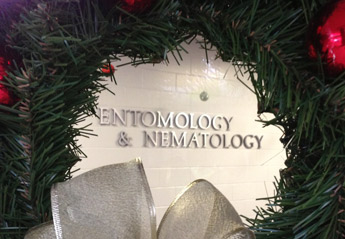
ABOVE: From everyone in the UF/IFAS Entomology & Nematology family, we hope you and yours have a very safe and happy winter break. See you in January!
Dr. Christine W. Miller is the recipient of a Learning Without Borders Curriculum Internationalization Award for the course ENY2890, Insect Research and Scientific Engagement.

ABOVE: The women in our Department were well represented at the Entomological Society of America’s program symposium titled “Grand Challenges: Tackling Invasive Species and Communication Strategies.” The session was co-organized and moderated by Dr. Faith Oi (left in photo) of the Medical, Veterinary, and Urban Entomology (MUVE) section. Dr. Oi also served on the opening panel led by ESA past-president Frank Zalom (UC Davis). Opening remarks were provided by ESA Executive Director Dr. David Gammel. UF Entomology was represented by two early career professionals who were nominated by their sections: Dr. Andrea Lucky (right in photo) who represented Systematics, Evolutionary, and Biodiversity (SysEB) section and spoke about “Pavement ants to population genomics: How citizen science can benefit invasion science” and Dr. Kirsten Pelz-Stelinski who represented Physiology, Biochemistry and Toxicology (PBT) section and spoke about “Microbial ecology of Asian citrus psyllid.”
The session was closed by NIFA Director Dr. Sonny Ramaswamy (center of photo) who delivered a rousing keynote: “A view from Washington DC” where he urged entomologists to continue engagement in the fight against nutritional insecurity. The Grand Challenges were initiated by several ESA presidents with the goal of improving the human condition through the science of entomology in the areas of invasive species, sustainable agriculture, and public health related to vector borne diseases.
 Dr. Thomas Chouvenc attended the “Invasive conehead termite IPM working group” session, organized by FDACS, which took place in Fort Lauderdale on Nov. 29th 2017. This invasive termite (Nasutitermes corniger), first detected in 2001 in Broward county is under an eradication program, but pockets of the population remain difficult to detect and control.
Dr. Thomas Chouvenc attended the “Invasive conehead termite IPM working group” session, organized by FDACS, which took place in Fort Lauderdale on Nov. 29th 2017. This invasive termite (Nasutitermes corniger), first detected in 2001 in Broward county is under an eradication program, but pockets of the population remain difficult to detect and control.
Dr. Thomas Chouvenc and Dr. Andrea Lucky were interviewed for an article on the Sun Sentinel about the discovery of the newest invasive ant species (Plagiolepis alluaudi) in south Florida.
A paper by Dr. Chouvenc and Dr. Nan-Yao Su on the efficacy of bait systems against invasive subterranean termites, recently published in Journal of Economic Entomology, was highlighted in Entomology Today.
 Dr. Oscar Liburd was an invited guest speaker for the Florida Organic Blueberry Growers annual workshop in Pinetta, Florida.
Dr. Oscar Liburd was an invited guest speaker for the Florida Organic Blueberry Growers annual workshop in Pinetta, Florida.
 Each Fall Dr. Andrea Lucky hosts a Collections Grading Party for entomologists to share their expertise and assist in identifying the insects in student collections from Insect Classification (ENY 4161 and ENY 6166). This year’s event on November 29th was well attended, with more than a dozen participants from the department, the McGuire Center, DPI and the FSCA. Attendees included: Kathy Arguez, Lyle Buss, Dr. Susan Halbert, Dr. James Hayden, Dr. Jiri Hulcr, Oliver Keller, Dr. Rachel Mallinger, David Plotkin, Dr. Marc Rothschild, Kyle Schnepp, Dr. Paul Skelley, Dr. Gary Steck, Dr. Elijah Talamas and Jason Williams. Student collections were scrutinized and there was general agreement that the collections looked good. A big thank you to everyone who attended and congratulations to the students for their hard work and excellent collections!
Each Fall Dr. Andrea Lucky hosts a Collections Grading Party for entomologists to share their expertise and assist in identifying the insects in student collections from Insect Classification (ENY 4161 and ENY 6166). This year’s event on November 29th was well attended, with more than a dozen participants from the department, the McGuire Center, DPI and the FSCA. Attendees included: Kathy Arguez, Lyle Buss, Dr. Susan Halbert, Dr. James Hayden, Dr. Jiri Hulcr, Oliver Keller, Dr. Rachel Mallinger, David Plotkin, Dr. Marc Rothschild, Kyle Schnepp, Dr. Paul Skelley, Dr. Gary Steck, Dr. Elijah Talamas and Jason Williams. Student collections were scrutinized and there was general agreement that the collections looked good. A big thank you to everyone who attended and congratulations to the students for their hard work and excellent collections!

ABOVE:Some of this semester’s students posed with their collections for a photo before the grading party began (L to R, back row) Alex Frezer, Juliana Carillo, Tanner Felbinger, Kristen Bowers, Nate Duerr, Matthew Gendreau, Elizette Rodriguez, (L to R, front row) Sierra Short, Ivy Grob, Ana Paula Carvalho, Emily Steffes (photo by Andrea Lucky). They are anxiously awaiting their grades!
 Dr. Phil Lounibos from the Florida Medical Entomology Laboratory was recently
awarded the Florida Mosquito Control Association’s Joseph Y. Porter Distinguished
Achievement Award in recognition of his significant contributions to entomology,
with special emphasis on the abatement of arthropods of public health importance.
Dr. Phil Lounibos from the Florida Medical Entomology Laboratory was recently
awarded the Florida Mosquito Control Association’s Joseph Y. Porter Distinguished
Achievement Award in recognition of his significant contributions to entomology,
with special emphasis on the abatement of arthropods of public health importance.
 Dr. Phil Kaufman and Dr. Jennifer Gillett-Kaufman will again perform their role as Faculty Program Directors for the UF in Florence - Global Perspectives Program. This is one of the largest study abroad programs offered by UF. Students in this program spend six weeks studying at the Florence University of the Arts. Join them Summer A 2018 to study abroad in Italy for their new class ALS 4404 Feast or Famine in Florence.
Dr. Phil Kaufman and Dr. Jennifer Gillett-Kaufman will again perform their role as Faculty Program Directors for the UF in Florence - Global Perspectives Program. This is one of the largest study abroad programs offered by UF. Students in this program spend six weeks studying at the Florence University of the Arts. Join them Summer A 2018 to study abroad in Italy for their new class ALS 4404 Feast or Famine in Florence.
 Dr. Adam Dale, Matthew Borden, Dr. Sydney Park Brown (Environmental Horticulture Department), Dr. Catharine Mannion, Lyle Buss, Dr. Xavier Martini, and Dr. Doug Caldwell (IFAS Extension Collier Co.) recently revised and published the Helpful, Harmful, Harmless insect identification deck. This updated identification deck is now available at the UF/IFAS Extension Bookstore.
Dr. Adam Dale, Matthew Borden, Dr. Sydney Park Brown (Environmental Horticulture Department), Dr. Catharine Mannion, Lyle Buss, Dr. Xavier Martini, and Dr. Doug Caldwell (IFAS Extension Collier Co.) recently revised and published the Helpful, Harmful, Harmless insect identification deck. This updated identification deck is now available at the UF/IFAS Extension Bookstore.
 Dr. Jiri Hulcr, Assistant Professor of Forest Entomology, was invited to give a keynote talk at the UF International Student Award Ceremony organized by the UF International Center.
Dr. Jiri Hulcr, Assistant Professor of Forest Entomology, was invited to give a keynote talk at the UF International Student Award Ceremony organized by the UF International Center.
 The textbook, Agricultural Acarology:An Introduction to Integrated Mite Management, is being translated into Greek. Dr. Marjorie Hoy is the author, but does not know Greek.
The textbook, Agricultural Acarology:An Introduction to Integrated Mite Management, is being translated into Greek. Dr. Marjorie Hoy is the author, but does not know Greek.
 Dr. James P. Cuda, Dr. Blair Siegfried and Dr. Faith Oi attended the first meeting of the IFAS Invasive Species Council Advisory Team held at the Austin Cary Forest Learning Center on 14 November. Dr. Cuda developed a PowerPoint training module on Brazilian peppertree biology/management that was evaluated by the team members. The Brazilian peppertree module is one of eight invasive species modules under development to be used by county faculty and their clientele. In addition Dr. James P. Cuda participated in a UF/IFAS Invasive Plant Working Group Meeting held on campus on November 30th.
Dr. James P. Cuda, Dr. Blair Siegfried and Dr. Faith Oi attended the first meeting of the IFAS Invasive Species Council Advisory Team held at the Austin Cary Forest Learning Center on 14 November. Dr. Cuda developed a PowerPoint training module on Brazilian peppertree biology/management that was evaluated by the team members. The Brazilian peppertree module is one of eight invasive species modules under development to be used by county faculty and their clientele. In addition Dr. James P. Cuda participated in a UF/IFAS Invasive Plant Working Group Meeting held on campus on November 30th.
Laura Harmon presented a virtual poster at the annual Entomological Society of America meeting in Denver, CO. This involved the preparation of a poster and a 3 minute video to be played alongside the poster at the venue. Her poster entitled Determining the lethal concentrations of permethrin for a laboratory reared colony of Culicoides sonorensis (Diptera: Ceratopogonidae) won second prize in the MUVE category. Her co authors were her advisor Dr. Emma Weeks, and her committee members Dr. Katherine Sayler (WEC) and Dr. Nathan Burkett-Cadena. The project was conducted at the USDA-ARS Arthropod-borne Animal Diseases Unit in Manhattan, KS with Dr. Elin Maki (a co-author on the presentation) in the laboratory of Dr. Lee Cohnstaedt.
 DPM and MSc ENTstudent Matt Borden (Landscape Entomology Lab, Dr. Adam Dale) won 2nd place for his oral presentation (General Ecology) at the EntSoc meeting last month. He also received two acceptances to the Insect Photo Salon competition, and produced a winning video for the P-IE (Plant-Insect Ecosystems) section's Pollinator Video Contest. The video, "Driving Change: Pollinator Conservation in the Urban Landscape" showcases the research that Dr. Dale and undergraduate researchers Rebecca Perry and Grace Cope are conducting at golf courses in the area. The video can be viewed at https://dalelab.org/videos/.
DPM and MSc ENTstudent Matt Borden (Landscape Entomology Lab, Dr. Adam Dale) won 2nd place for his oral presentation (General Ecology) at the EntSoc meeting last month. He also received two acceptances to the Insect Photo Salon competition, and produced a winning video for the P-IE (Plant-Insect Ecosystems) section's Pollinator Video Contest. The video, "Driving Change: Pollinator Conservation in the Urban Landscape" showcases the research that Dr. Dale and undergraduate researchers Rebecca Perry and Grace Cope are conducting at golf courses in the area. The video can be viewed at https://dalelab.org/videos/.
 DPM and MSc ENT students Morgan Pinkerton, Eleanor Phillips, Matt Borden, and Dr. Lisbeth Espinoza (DPM and MSc ENT alumni) gave a seminar presentation on December 4th about the DPM study-abroad trip to Ecuador earlier this year. The class visited ESPOL University, agricultural research organizations, and production sites for key commodities in Ecuador, including banana, cacao, potatoes, sugarcane, and roses.
DPM and MSc ENT students Morgan Pinkerton, Eleanor Phillips, Matt Borden, and Dr. Lisbeth Espinoza (DPM and MSc ENT alumni) gave a seminar presentation on December 4th about the DPM study-abroad trip to Ecuador earlier this year. The class visited ESPOL University, agricultural research organizations, and production sites for key commodities in Ecuador, including banana, cacao, potatoes, sugarcane, and roses.
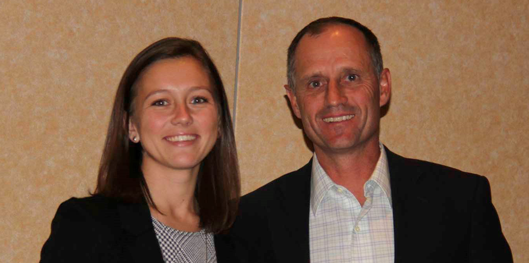
ABOVE: Ms. Casey Parker, a Ph.D. student of Dr. C. Roxanne Connelly, attended the Florida Mosquito Control Association meeting held in Kissimmee, FL where she gave an oral presentation titled “Distribution and insecticide susceptibility status of Florida populations of Aedes aegypti and Aedes albopictus” and gave another presentation to Florida mosquito control commissioners on insecticide resistance. Casey was also awarded the T. Wainwright Miller Scholarship at this meeting. (Photograph by P. H. Connelly)
 Rebecca Perry and Grace Cope (undergraduate students in the Dale Lab) presented posters about their research at the UF CURBS Undergraduate Research Symposium on October 31st.
Rebecca Perry and Grace Cope (undergraduate students in the Dale Lab) presented posters about their research at the UF CURBS Undergraduate Research Symposium on October 31st.
Dr. Pablo Allen, Matt Borden, Ethan Doherty, Brianna Whitman, Rebecca Perry, and Grace Cope each traveled to Denver, CO to represent the Dale Lab by each giving oral research presentations at the National Entomology Conference.
Ethan Doherty (graduate student in the Dale Lab) received second place in the graduate student 10-minute oral presentation competitions at the National Entomology meeting in Denver, CO.
 Casey Parker, one of our graduate students at FMEL recently won first prize in her category at the Entomological Society of America Student Competition, and was also awarded a T. Wayne Miller scholarship by the Florida Mosquito Control Association.
Casey Parker, one of our graduate students at FMEL recently won first prize in her category at the Entomological Society of America Student Competition, and was also awarded a T. Wayne Miller scholarship by the Florida Mosquito Control Association.
 In November, three members of the Miller Lab (Dr. Michael Forthman, Dr. Pablo Allen, and Ebony Taylor) attended the Entomological Society of America conference in Denver, Colorado. Dr. Forthman co-organized the “Breaking into the Biobank: Promising Methods for Sequencing DNA from Museum Arthropod Specimens” symposium and Dr. Allen gave an oral presentation titled, “From conception to submission: Course-based Undergraduate Research Experience using insects.” Finally, Ebony Taylor, an undergraduate in the Miller Lab, attended her first scientific conference.
In November, three members of the Miller Lab (Dr. Michael Forthman, Dr. Pablo Allen, and Ebony Taylor) attended the Entomological Society of America conference in Denver, Colorado. Dr. Forthman co-organized the “Breaking into the Biobank: Promising Methods for Sequencing DNA from Museum Arthropod Specimens” symposium and Dr. Allen gave an oral presentation titled, “From conception to submission: Course-based Undergraduate Research Experience using insects.” Finally, Ebony Taylor, an undergraduate in the Miller Lab, attended her first scientific conference.
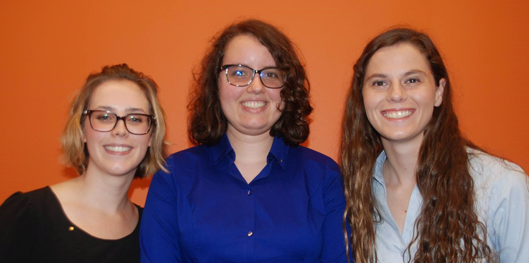
ABOVE: On November 30, Abigail Prohofsky (center), an undergraduate entomology major, was inducted into the honorary agriculture fraternity, Alpha Zeta. Abigail also received the Most Outstanding New Member award from the chapter for her diligence and hard work in achieving her volunteer hours and other activities required by pledges. Alpha Zeta is an honorary, professional society for students and industry professionals in the agriculture and natural resources fields. Any undergraduate majors or minors interested in learning more about the society can contact Dr. Phil Kaufman, the chapters Faculty Advisor. Also in the photo Virginia Propheter (on left, is President) and Kristen Doyle (on right, is Vice President), Kristen joined the Kaufman's for their 2017 study abroad course in Italy.
 In addition to our student winners at ESA that were listed in last months and this months newsletters we would also like to recognize Cory Penca-who placed second in his group.
In addition to our student winners at ESA that were listed in last months and this months newsletters we would also like to recognize Cory Penca-who placed second in his group.
 Sara Salgado, an intern in Dr. Carey Minteer’s lab, was recognized for “Best Thesis” by the Zamorano Pan-American Agricultural School. Work for Sara’s thesis “Respuesta de hipersensibilidad de la maleza invasora Brazilian peppertree (Schinus terebinthifolia) a Calophya spp.” was conducted during Sara’s internship in the Minteer Lab at the Hayslip Biological Control Research and Containment Laboratory in the spring of 2017.
Sara Salgado, an intern in Dr. Carey Minteer’s lab, was recognized for “Best Thesis” by the Zamorano Pan-American Agricultural School. Work for Sara’s thesis “Respuesta de hipersensibilidad de la maleza invasora Brazilian peppertree (Schinus terebinthifolia) a Calophya spp.” was conducted during Sara’s internship in the Minteer Lab at the Hayslip Biological Control Research and Containment Laboratory in the spring of 2017.
Need to name that bug? A host of experts are available to help Floridians identify any insect or related arthropod. If a mystery creature has six or more legs, the UF Insect ID Lab is the place to call.
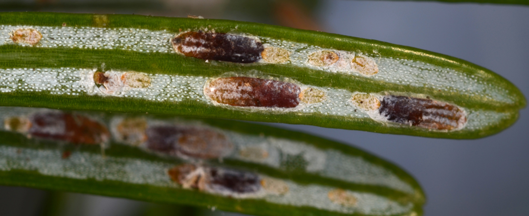
ABOVE: It is getting colder and bugs are less active, but that does not mean we can let our guard down! Exotic species are moving around even at this time of year. People are inadvertently helping this happen through the movement of Christmas trees. One such species that has been intercepted in Florida many times is the elongate hemlock scale, Fiorinia externa. The sample in the picture shows the scales on a Fraser’s fir from North Carolina. Luckily, the scale’s main hosts (hemlock, spruce, and fir) do not naturally occur in Florida. Other potential hosts like pine and junipers are common in the state, but the scale hasn’t yet been detected in the environment.
Need insect images? You can go to this direct link, pictures are copyrighted material and intended for official UF use only, log onto the website using your Gatorlink credentials.
Lyle Buss is the Insect ID Lab manager.
 Think it might be a nematode problem? The Nematode Assay Laboratory serves Florida and other states by providing nematode assays and expert advice regarding nematode management.
Think it might be a nematode problem? The Nematode Assay Laboratory serves Florida and other states by providing nematode assays and expert advice regarding nematode management.
For more information on the Nematode Assay Laboratory please contact the lab manager Dr. Tesfa Mengistu.
Aldridge RL, Kaufman PE, Bloomquist JR, Gezan SA, Linthicum KJ. 2017. Application site and mosquito age influences malathion- and permethrin-induced mortality in Culex quinquefasciatus. Journal of Medical Entomology 54: 1692-1698. DOI: 10.1093/jme/tjx160.
Cattau CE, Fletcher RJ, Miller CW, Kimball RT, Kitchens WM. 2017. Rapid morphological change of a top predator with the invasion of a novel prey. Nature Ecology and Evolution DOI:10.1038/s41559-017-0378-1.
This article in the news!
- https://www.nytimes.com/2017/11/28/science/birds-beaks-evolution-snails.html
- http://www.cbc.ca/news/technology/evolution-kite-finches-1.4421594
- http://nationalpost.com/news/world/proof-of-evolution-birds-grow-larger-beaks-in-less-than-a-decade
- https://natureecoevocommunity.nature.com/channels/521-behind-the-paper/posts/24716-an-invasive-prey-and-the-beak-of-the-kite
- https://arstechnica.com/science/2017/11/big-invasive-snails-are-driving-birds-of-prey-to-get-bigger/?comments=1&post=34413339
Chouvenc T, Scheffrahn RH, Mullins AJ, Su NY. 2017. Flight phenology of two Coptotermes species (Isoptera: Rhinotermitidae) in southeastern Florida. Journal of Economic Entomology 110: 1693-1704.
Chouvenc T, Su NY. 2017. Subterranean termites feeding on CSI baits for a short duration still results in colony elimination. Journal of Economic Entomology 110: 2534-2538.
Chouvenc T, Su NY. 2017. Testing the role of cuticular hydrocarbons on intercolonial agonism in two subterranean termite species (Coptotermes) and their hybrids. Insectes Sociaux 64: 347-355.
Joseph PN, Emberts Z, Sasson DA, Miller CW. 2017. Males that drop a sexually-selected weapon grow larger testes. Evolution DOI: 10.1111/evo.13387. Press: Disarmed, But Not Impotent.
Hertz JC, Ferree Clemons BC, Lord CC, Allan SA, Kaufman PE. 2017. Distribution and host associations of ixodid ticks collected from wildlife in Florida. Experimental and Applied Acarology 73: 223-236. DOI: 10.1007/s10493-017-0183-1.
Iglesias LE, Liburd OE. 2017. Identification of bio-rational insecticides for managing spotted wing drosophila in organic blueberry. Acta Hortic 1180: 283-291.
Klafke G, Miller R, Tidwell J, Barreto R, Guerrero F, Kaufman P, Perez de Leon B. 2017. Mutation in the sodium channel gene corresponds with phenotypic resistance of the brown dog tick, Rhipicephalus sanguineus sensu lato (Latreille)(Acari: Ixodidae) to pyrethroids. Journal of Medical Entomology 54: 1639-1642. DOI: 10.1093/jme/tjx060.
Kumar V, Dickey AM, Seal DR, Shatters, RG, Osborne LS, McKenzie CL. 2017. Unexpected high intragenomic variation in two of three major pest thrips species does not affect ribosomal internal transcribed spacer 2 (ITS2) utility for thrips identification. International Journal of Molecular Sciences 18: 2100. doi:10.3390/ijms18102100.
Kumar V, Avery PB, Ahmed J, Cave R, McKenzie CL, Osborne LS. 2017. Compatibility and efficacy of Isaria fumosorosea with horticultural oils for mitigation of the Asian citrus psyllid, Diaphorina citri (Hemiptera: Liviidae). Insects 8: 19. doi:10.3390/insects8040119.
Kumar V, Kakkar G, Seal DR, McKenzie CL, Osborne LS. 2017. Evaluation of insecticides for curative, preventive and rotational use on Scirtothrips dorsalis South Asia 1. Florida Entomologist 100: 634-646.
Kumar V, Palmer C, McKenzie CL, Osborne LS. 2017. Whitefly management program for ornamental plants. UF/IFAS EDIS publication. Entomology and Nematology Department, University of Florida, EDIS# ENY-989.
Lake EC, Minteer CR. 2017. A review of the integration of classical biological control with other techniques to manage invasive weeds in natural areas and rangelands. BioControl. 00: 1-16. DOI:10.1007/s10526-017-9853-5.
Liburd OE, Razze JM, Nyoike TW. 2018. Relative captures of grape root borer, Vitacea polistiformis (Lepidoptera: Sesiidae) in pheromone traps within vineyards and adjacent woodlands. Crop Protection 105: 35-40.
Martini X, Stelinski LL. 2017. Drought stress affects response of phytopathogen vectors and their parasitoids to infection- and damage-induced plant volatile cues. Ecological Entomology 42: 721-730.
Rhodes EM, Liburd OE. 2017. Flower thrips (Thysanoptera: Thripidae and Phlaeothripidae) species complex on Florida blackberries and the effect on blackberry cultivar. Florida Entomologist 100: 478-480.
Rhodes EM, Benda N, Liburd OE. 2017. Monitoring and distribution of blueberry gall midge Dasineura oxycoccana, in rabbiteye blueberries in Florida. Acta Hortic 1180: 305-312.
Simisky T, Norton R, Kumar V. 2017. Chilli thrips factsheet, UMass Extension Landscape, Nursery & Urban Forestry Program.
Somjee U, Miller CW, Tatarnic NJ, Simmons LW. 2017. Experimental manipulation reveals a trade-off between
weapons and testes. Journal of Evolutionary Biology DOI: 10.1111/jeb.13193.
Stockton DG, Pescitelli LE, Ebert TA, Martini X, Stelinski LL. 2017. Induced preference improves offspring fitness in a phytopathogen vector. Environmental Entomology 46: 1090-1097.
Tipping PW, Gettys LA, Minteer CR, Foley JR, Sardes SN. 2017. Herbivory by biological control agents improves herbicidal control of waterhyacinth (Eichhornia crassipes). Invasive Plant Science and Management 10: 271-276.
Tucker NSG, Kaufman PE, Weeks ENI, Rowland J, Tidwell J, Miller RJ. 2017. Characterization of a sodium channel mutation in permethrin-resistant Rhipicephalus sanguineus (Acari: Ixodidae). Journal of Medical Entomology 54: 1633-1638. DOI: 10.1093/jme/tjx127.
Weeks ENI, Schmehl DR, Baniszewski J, Tome HVV, Cuda JP, Ellis JD, Stevens BR. 2017. Safety of methionine, a novel biopesticide, to adult and larval honey bees (Apis mellifera L.). Ecotoxicology and Environmental Science 149: 211-216.
 New on Featured Creatures:
New on Featured Creatures:
Do you have a favorite creature? Learn how to make it into a Featured Creature!Ebony jewelwing, Calopteryx maculata (Beauvois, 1807) Authors: Alfred Runkel IV, Nathan Burkett-Cadena, and Andrea Lucky.
Lively cuckoo bee, Nomada fervida Smith. Authors: Jason L. Williams, Cameron Jack, Jamie Ellis.
Podocarpus aphid, Neophyllaphis podocarpi Takahashi. Authors: Eleanor F. Phillips and Jennifer L. Gillett-Kaufman.
Yellow Brazilian peppertree leaf-galler, Calophya latiforceps Burckhardt. Authors: James P. Cuda, Patricia Prade, and Carey R. Minteer.
Tobacco hornworm, Manduca sexta (Linnaeus). Authors: Morgan A. Byron and Jennifer L. Gillett-Kaufman.
Dr. Zane Grabau and Dr. Don Dickson traveled to Raleigh, NC to attend the S1066 Nematology Working Group meeting on November 13th and 14th.
Dr. Zane Grabau presented his work on nematicides in peanut production at the Bayer Peanut Cooperators Regional Meeting in Savannah, GA from December 6th to the 8th.
 On November 9th Dr. Billy Crow presented “Nematode management on turf, 2017” and “Earthworms, friend or foe?” at the Florida A&M University annual field day and workshop in Tallahassee, FL.
On November 9th Dr. Billy Crow presented “Nematode management on turf, 2017” and “Earthworms, friend or foe?” at the Florida A&M University annual field day and workshop in Tallahassee, FL.
 Dr. Faith Oi was invited to speak at the Federation of Asian and Oceania Pest Managers' Association (FAOPMA)-Pest Summit meeting (November 22nd to the 24th) to almost 1,500 PMPs from 35 counties on “What the World Would Look Like without Pest Control” and “Books, Backpacks and Bugs: IPM in Public Schools.” Alumni Dr. Dini Miller, now Professor at Virginia Tech, also spoke at this meeting on German cockroaches in public housing and bed bugs. Faith also gave an additional presentation to the Japan Pest Control Association on Fire Ants and Their Management. The red important fire ant is a new invasive species to Japan, found in 2017, and is now known to infest 35 ports in Japan.
Dr. Faith Oi was invited to speak at the Federation of Asian and Oceania Pest Managers' Association (FAOPMA)-Pest Summit meeting (November 22nd to the 24th) to almost 1,500 PMPs from 35 counties on “What the World Would Look Like without Pest Control” and “Books, Backpacks and Bugs: IPM in Public Schools.” Alumni Dr. Dini Miller, now Professor at Virginia Tech, also spoke at this meeting on German cockroaches in public housing and bed bugs. Faith also gave an additional presentation to the Japan Pest Control Association on Fire Ants and Their Management. The red important fire ant is a new invasive species to Japan, found in 2017, and is now known to infest 35 ports in Japan.
Dr. Faith Oi was invited to speak at the 16th annual PestExpo (November 9th) to >500 PMPs from predominantly the New York-New Jersey area.
From the Outreach Coordinator
The live critters are always a hit with children and adults alike. The critters are available for you to check out should you be leading an outreach event. We have doubles of our most popular critters, as well as various native insect species depending on the time of year. We have large wood and Plexiglas cages for viewing our native orb weaving spiders. There is one travel cage and one larger static cage. Please be sure to contact us and review the protocol on transporting and handling the critters if you are not already familiar with it. If you lead an outreach, be sure to fill out a documentation form so your event can be included in the newsletter and we can log all outreach events.
A big thank you to the students and faculty who volunteered for November’s outreach events.
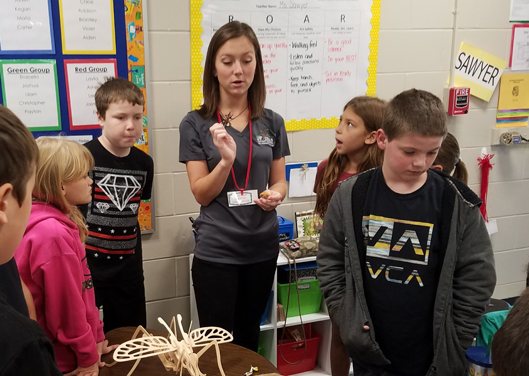
ABOVE: On December 1st, East Marion Elementary School in Ocala held its 2nd annual Career Day. Casey Parker, a Ph.D. student, was there to represent careers in science and entomology!
If you would like to schedule an event or have any outreach questions, go to the Outreach pages on our Bug Club website and contact us. If you have any questions, please email me.
Thank you — Laurel Lietzenmayer, Outreach Coordinator.
Dr. Brian Bahder has received a $87,296 grant in collaboration with Dr. Erica Goss from the Emerging Pathogens Institute to sequence and analyze the genomes of phytoplasmas infecting palms in Florida and the Caribbean.
 Dr. Adam Dale, Dr. Gul Shad Ali (Department of Plant Pathology, MREC), and Erin Harlow (Duval County Extension) were awarded a $5,000 FNGLA Endowed Research Fund grant titled, "Investigating the causal agent of bud galls on Florida ornamental plants."
Dr. Adam Dale, Dr. Gul Shad Ali (Department of Plant Pathology, MREC), and Erin Harlow (Duval County Extension) were awarded a $5,000 FNGLA Endowed Research Fund grant titled, "Investigating the causal agent of bud galls on Florida ornamental plants."
 Getting social!
Getting social!
We have several social media sites for the Entomology & Nematology Department. To make them easily searchable, all three (YouTube, Facebook and Twitter) have the same page name: UFEntomology. Please share these links with past students or colleagues who may have an interest in departmental activities.
We like to share news when it happens using our social media outlets: Twitter, Facebook and YouTube. Follow us on these sites for daily updates! When you send news, we will post it on one or more of these sites and again in the monthly newsletter. Please be sure you have permission from people in photographs you submit for publication.
UF-Bugnews-L listserv subscribers receive notices when issues are posted. Our home page has instructions for subscribing and unsubscribing.
Special thanks to Haleigh Ray and Nancy Sanders who reviewed the newsletter for errors and to Jane Medley and Don Wasik who built the web page design.